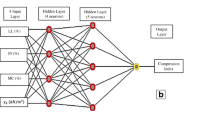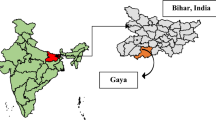Abstract
In this study, Random Forest Regressor, Linear Regression, Generalized Regression Neural Network (GRNN) and Fully connected Neural Network (FCNN) models are leveraged for predicting unconfined compression coefficient with respect to standard penetration test (N-value), depth and soil type. The study is focused on a particular correlation of undrained shear strength of clay (Cu) with the standard penetration strength. The data used is from 14 no. ward in Mymensingh and Rangamati districts which are situated in Bangladesh. By using this data, the study tries to solidify the correlation of SPT (N-value) with Cu. It also tries to check the goodness of the relationship by comparing it with unconfined compression strength values gained from the unconfined compression test calculated from the field by experts.
Access this chapter
Tax calculation will be finalised at checkout
Purchases are for personal use only
Similar content being viewed by others
References
Balachandran, K., Liu, J., Cao, L., Peaker, S.: Statistical correlations between undrained shear strength (CU) and both SPT-N value and net limit pressure (PL) for cohesive glacial tills
Bolton Seed, H., Tokimatsu, K., Harder, L., Chung, R.M.: Influence of SPT procedures in soil liquefaction resistance evaluations. J. Geotech. Eng. 111(12), 1425–1445 (1985)
Bui, D.T., Nhu, V.H., Hoang, N.D.: Prediction of soil compression coefficient for urban housing project using novel integration machine learning approach of swarm intelligence and multi-layer perceptron neural network. Adv. Eng. Inform. 38, 593–604 (2018)
Grima, M.A., Babuška, R.: Fuzzy model for the prediction of unconfined compressive strength of rock samples. Int. J. Rock Mech. Min. Sci. 36(3), 339–349 (1999)
Hara, A., Ohta, T., Niwa, M., Tanaka, S., Banno, T.: Shear modulus and shear strength of cohesive soils. Soils Found. 14(3), 1–12 (1974)
Kingma, D.P., Ba, J.: Adam: A method for stochastic optimization (2014). arXiv preprintarXiv:1412.6980
Kovacs, W.D., Salomone, L.A.: Closure to “SPT hammer energy measurement” by William D. Kovacs and Lawrence A. Salomone (April, 1982). J. Geotech. Eng. 110(4), 562–564 (1984)
Puri, N., Prasad, H.D., Jain, A.: Prediction of geotechnical parameters using machine learning techniques. Procedia Comput. Sci. 125, 509–517 (2018)
Robertson, P., Campanella, R., Wightman, A.: SPT-CPT correlations. J. Geotech. Eng. 109(11), 1449–1459 (1983)
Sarkar, G., Siddiqua, S., Banik, R., Rokonuzzaman, M.: Prediction of soil type and standard penetration test (SPT) value in Khulna city, Bangladesh using general regression neural network. Q. J. Eng. Geol. Hydrogeol. 48(3), 2014-2108 (2015). Geological Society of London
Schmertmann, J.H., Palacios, A.: Energy dynamics of SPT. J. Geotechnical Eng. Div. 105(8), 909–926 (1979)
Specht, D.F., et al.: A general regression neural network. IEEE Trans. Neural Netw. 2(6), 568–576 (1991)
Yılmaz, I., Sendır, H.: Correlation of schmidt hardness with unconfined compressive strength and young’s modulus in gypsum from Sivas (Turkey). Eng. Geol. 66(3–4), 211–219 (2002)
Acknowledgment
The authors would like to thank the Department of Urban and Regional Planning from Bangladesh University of Engineering and Technology for providing us with the related datasets from Mymensingh Ward 14.
Author information
Authors and Affiliations
Corresponding author
Editor information
Editors and Affiliations
Rights and permissions
Copyright information
© 2020 Springer Nature Switzerland AG
About this paper
Cite this paper
Sarwar, A.M. et al. (2020). Soil Analysis and Unconfined Compression Test Study Using Data Mining Techniques. In: Hernes, M., Wojtkiewicz, K., Szczerbicki, E. (eds) Advances in Computational Collective Intelligence. ICCCI 2020. Communications in Computer and Information Science, vol 1287. Springer, Cham. https://doi.org/10.1007/978-3-030-63119-2_4
Download citation
DOI: https://doi.org/10.1007/978-3-030-63119-2_4
Published:
Publisher Name: Springer, Cham
Print ISBN: 978-3-030-63118-5
Online ISBN: 978-3-030-63119-2
eBook Packages: Computer ScienceComputer Science (R0)




